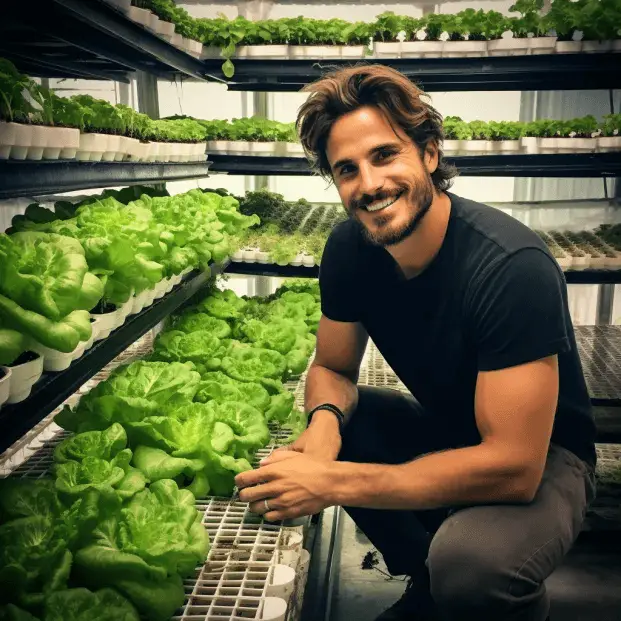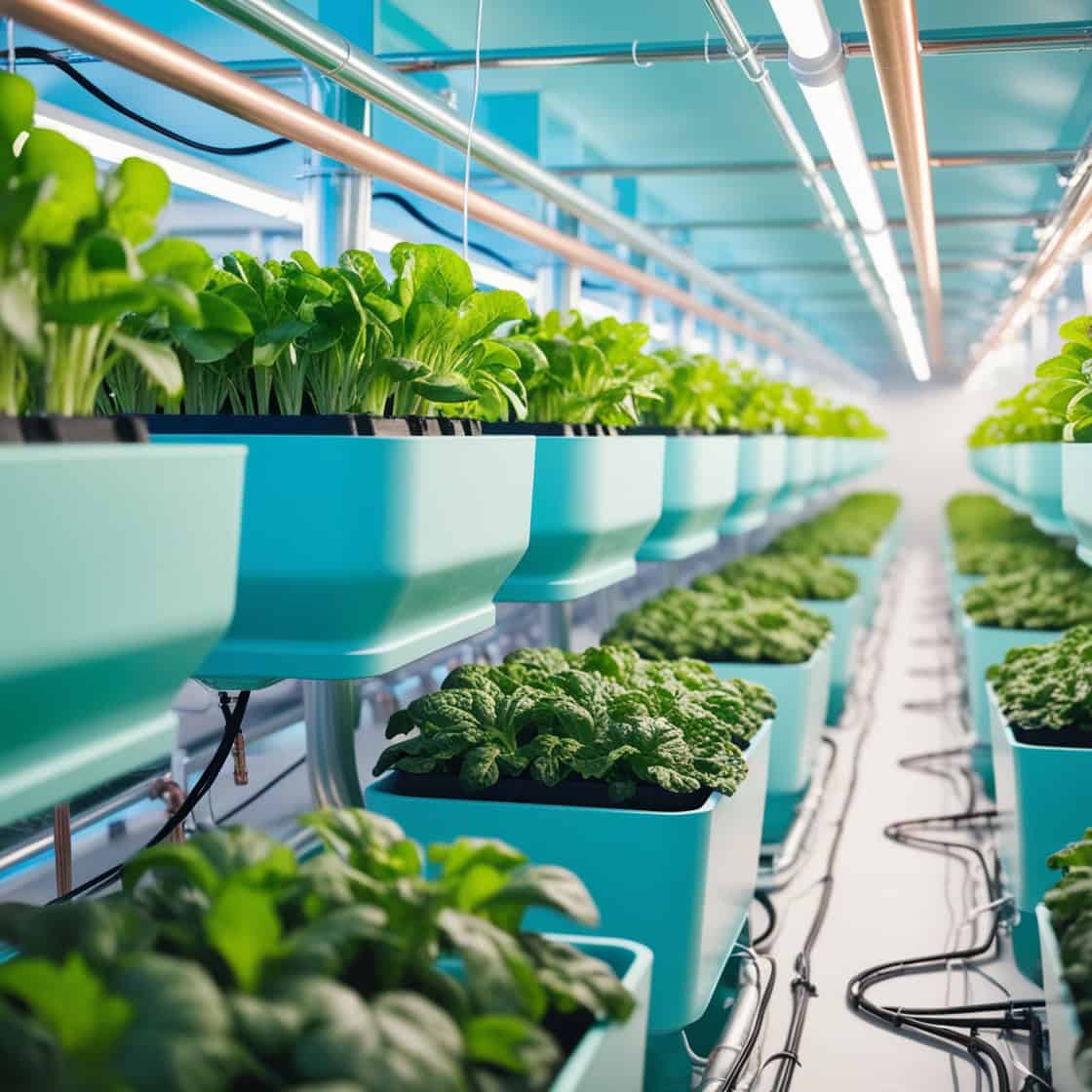Growing plants indoors using ebb and flow hydroponics is fascinating way for some to cultivate green life without soil. Often called flood and drain, this system permits plant roots to soak up nutrient-full water while also receiving good airflow. As one gardener explains, “hydroponics is a method letting you raise plants minus soil.” For those seeking to harvest wholesome greens where space is limited, continue reading to discover how this technique functions. This beginner-friendly process makes indoor gardening a realistic option for nurturing nature regardless of setting.
Key Takeaway
- Ebb and flow hydroponics is more efficient with water use than regular gardening.
- In this system, plant roots can get oxygen which helps them grow well.
- You can grow different kinds of plants inside all year long.
Growing Plants Without Soil
Have you ever wanted to grow your own plants but didn’t have space for soil? Ebb and flow hydroponics is a simple way to do just that. This method uses a cycle of flooding and draining to feed plants and keep their roots healthy, without needing dirt.
Instead of soil, plants get nutrients from water. The water solution holds all the food that plants need to thrive. To start the cycle, water floods a tray holding the plants. This soaking allows the roots to easily take up good nutrients. Then the water drains away so the roots can get a break before the next flood.
Repeating this flood-then-drain pattern is like how some plants experience rain and dry periods naturally. But doing it inside means being able to garden all year long, even when space is limited. The process also stays low-maintenance no matter how many plants you have.
Overall, ebb and flow hydroponics makes for a great growing environment with minimal effort from you. With this method, anyone can successfully grow their own salads and greens without worries over soil. Both new and experienced indoor gardeners will find it an easy way to plant without plowing (1).
How Does the System Work?
Credits : Proponics
Understanding how ebb and flow hydroponics works is simple. At its core, the system relies on three central parts to keep plants well-watered and fed.
A grow tray holds the plants above a lower reservoir that acts as the watering can. Pipes connect the two areas so that a controlled pump can easily move the nutrient solution where it’s needed most.
On a pre-set schedule, the pump fills the tray with the life-sustaining water from below. Roots readily receive essential minerals as they bathe. Once refreshed, the pump then rests while gravity empties excess back to the reservoir.
This repeating flood-and-drain cycle mimics nature’s rhythm that many plants naturally follow. Critically, it also allows air to periodically reach the depths where roots spread. The alternating access between water and oxygen is key to fueling healthy expansion.
All the while, monitoring is kept to a minimum thanks to the timer’s hand. It ensures predictable, regular nourishment during both day and night so people can relax, trusting their indoor garden is in reliable care. With only three core parts working together harmoniously, success is attainable for any green thumb (2).
Benefits of Ebb and Flow Hydroponics
Ebb and flow hydroponics delights indoor gardeners with several key perks. For one thing, it treats water with care, ensuring efficient and continuous reuse. People find joy knowing less liquid goes unused, helping both plant and planet.
Your garden stays remarkably pest-free since there’s no soil for unwanted visitors to call home. This natural protection means you can grow confidently without worrying about common garden troubles that plague traditional plots.
Flexibility also blossoms with this method. From leafy friends to robust veggies, all kinds find a loving home regardless of size. Experimenting brings ongoing excitement as each season debuts new duos.
Harmony holds too in a vital drainage pulse. When trays empty, thirsty roots breathe freely once more. This balance of wet and dry builds resilience to endure future challenges with grace.
Perhaps best of all – a feast of freshness awaits year-round. Rain or shine outdoors matters not, for indoor yields continue unperturbed. Such unwavering bounty brings smiles remembering nature’s cycle perpetually spins.
For water stewards and curious growers alike, ebb and flow invites discovery and delight (3).
Considerations for Indoor Use
Setting up ebb and flow hydroponics calls for thoughtful preparation indoors. Gardeners first gauge available space to waltz with wicking trays and watering cans. Scale starts small where room proves tight, building as bounds broaden.
Lighting lingers top priority too. Green companions depend on the sun’s stead, even when behind glass. Bright beams from energy-thrifty lamps lend the right wavelengths to nurture growth at any hour.
Frequent check-ins also prove their care. Dipping test-tubes ensures fluids stay at pH levels in balance. Nutritional needs stay met from such watchful eyes. With judicious tests, crops stay hearty and yield bounties.
Lastly, surroundings impact the hydro-home. Warm welcomes arise where air flows free and frosts shan’t form. In stable spots indoors, indoor farmers see nature’s rhythms flow reliably on.
Common Growing Media
When setting up an ebb and flow system, selecting the right root bed holds impact. Popular picks suit plants’ needs in their own way.
Clay pebbles ease both drainage and breathing room. Their solid yet airy structure prevents soggy distress while retaining some moisture to nourish thirsts.
Coco coir calls upon coconut’s bounty too. Made from husks, its organic feel keeps roots comfortably moist while permeable parts oxygenate the underground domain. Plus earthy materials biodegrade naturally when their job is done.
Those also opt for wool cut from rocks find rewards. Its water-holding yet fluffy attributes ready the path for expansion. Sizes vary as plants develop, extending convenience.
Each medium showcases pluses growing souls appreciate. Getting to know roots’ requirements helps indoor gardeners discern which partner will deliver long-term care through their hydroponic journey indoors. Exploring the options ensures only the best fit for green Housemates.
Potential Challenges
While ebb and flow hydroponics brings rewards, responsibility joins its share of hurdles too. Reliable pumps prove their weight in caring for roots unscathed. Backups allow relief if wear slows a well’s flow.
Balance also matters most in nutrient-rich waters. Regularly checking pH and mineral mixes means green housemates stay healthy by the glass. Left too long without such check-ups invites issues.
Still waters too invite hitchhikers if lingered under lights. Algae can out-compete where drainage lags and access persists. Covering the reservoir prevents such algal overwhelm.
Lastly, space constraints indoors require planning to avoid crowded forests. Ensuring enough room allows saplings to spread their leaves – neither too tight nor far between.
With prudent precautions though, indoor farmers overcome challenges. Their diligence nurtures continued harvests all season long.
Automation and Maintenance
Thoughtful tinkering helps this hydroponic habitat hum. Automation frees people’s days through reliable rule. Timers tend tasks tuned to nature’s norm, ensuring steady irrigation just so. Plants prosper untended this way.
Still, maintenance proves its merit too. Checking fluids fortnightly prevents pesky buildups, granting greens ideal inputs. Diligent eyes note unusual scenes signaling replacement time.
Likewise, cleaning spares the system stress. Over months, algal others may encumber works – detracting from their duties. Regular scrub-downs though keep compartments clearflowing.
Parts also warrant watch. Should telltale troubles emerge, proactive exchange beats reactive repair. This upholding preserves smooth functioning far into the future.
By balancing considered construction with consistent care, indoor cultivators cultivate endlessly giving gardens delivering delight all through the days.
Types of Plants to Grow
A bounty of green companions lend themselves well to ebb and flow gardens indoors. Leafy friends most flock to its flow, thriving quickly while sharing abundantly. Lettuce, spinach and kale breeze through their days nourished so.
Herbs add seasoning too where space proves tight. Basil, cilantro and mint delight with fresh flavors anytime. Their petite presence means full frolic even underneath glass.
Fruits also find favor when finessed with care. Tomatoes and peppers bring colorful, tangy treats through prudent cultivation.
Overall, preferences and parameters dictate the plantings’ potential best. Ever-experimental growers test which temperaments harmonize within their domain, gladly growing what grows gladly there. With its versatility, ebb and flow ever proves the hydroponic habitat of choice for vegetables near and far.
FAQ
How does an ebb and flow hydroponic system work for indoor growing?
A basic ebb and flow system works by periodically flooding your grow bed with nutrient rich water from a water reservoir. The water pump moves water up to flood the growing tray, where plant roots absorb nutrients. After feeding, the water drains back into the reservoir through an overflow tube. This flood and drain system is controlled by a timer, making it perfect for indoor grow rooms and small scale gardening.
What growing media works best in ebb and flow hydroponics?
Your choice of growing media matters a lot. Popular options include coconut coir and other inert medium choices. The medium needs to work well with root systems, providing enough oxygen to the root zone while maintaining proper water levels. Dutch bucket systems often use different medium choices than traditional flood tables.
What are the pros and cons of ebb and flow hydroponic systems?
The pros include efficient nutrient delivery, healthy root mass development, and easy set up and maintain. This type of plant growing system works great for most plants, including root vegetables. The cons of ebb and flow include potential pump failures and the need to carefully monitor pH levels and nutrient solutions. Commercial growers often choose this system for its reliability.
How do I handle pests and diseases in my hydroponic system?
Keep your growing area clean and consider using hydrogen peroxide for sanitation. Monitor young plants closely for signs of trouble. Good air flow in your grow tent helps prevent issues. Many hydroponic gardening problems can be prevented by maintaining proper water flow rate and keeping the nutrient solution reservoir clean.
What’s needed to start an indoor ebb and flow system?
You’ll need a submersible pump or dual pump setup, flood tray, growing tray, oxygen/air pump, and overflow drain. The system requires proper growing mediums and a timer to control the flooding and draining cycles. This hydroponic system works well in a grow tent or small grow room, making it perfect for indoor grow situations.
Conclusion
Ebb and flow hydroponics is a clever way to cultivate green plants indoors absent soil. Commonly called “flood and drain,” this system recycles nutrients for optimized water use. Gardening gurus swear by its perks of conserving resources while nourishing an array of colorful crops any time. With some focus on setup and routine care, gardens indoors become reality for many eager to experience the satisfaction of seeing planted seeds prosper. Give it a try – your plants are sure to reward your efforts with fresh beauté.
References
- https://en.wikipedia.org/wiki/Ebb_and_flow_hydroponics
- https://www.rd.com/article/hydroponic-gardening/
- https://www.trees.com/gardening-and-landscaping/ebb-and-flow-hydroponics
Related Articles
- https://tophydroponicgarden.com/ebb-and-flow-system-guide/
- https://tophydroponicgarden.com/hydroponic-medium-ebb-and-flow/
- https://tophydroponicgarden.com/most-profitable-hydroponic-vegetables/
Was this helpful?

I’m Barrie L., a passionate hydroponic gardening enthusiast dedicated to cultivating thriving, soil-less gardens. With a focus on all things hydroponic, I share my expertise on innovative growing techniques and sustainable practices through my blog, tophydroponicgarden.com. As a seasoned hydroponics specialist, my goal is to inspire and guide fellow gardeners in harnessing the power of water-based cultivation for bountiful and eco-friendly harvests. I’m also an author of the book “Hydroponics For Absolute Beginners: Your Step By Step Guide For How To Create An Hydroponics System At Home Without Soil, For Growing Vegetable, Fruit And Herbs.” which is sold on Amazon. Join me on a journey of redefining the way we cultivate plants, one nutrient-rich solution at a time. Happy growing!


